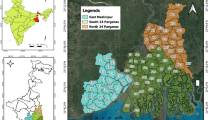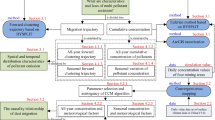Abstract
We use the Moderate Resolution Imaging Spectroradiometer (MODIS) sensor on both Terra and Aqua satellites to present new high-resolution mapping of major atmospheric dust source points in the Middle East region on the basis of the improved version of the recently developed Middle East Dust Index (MEDI) applied to 70 dust storms, which occurred during the period between 2001 and 2012. Results indicate that 247 different source points have participated in dust storm generation in the Middle East region in which Iraq and Syria are the highest efficient sites for dust storm generation in this region, respectively. Using extracted indices for Deep Blue algorithm, identified dust sources were classified into three levels of intensity. The frequency of occurrence approach, the relationship between high atmospheric dust content and its number of occurrences, is also used to identify sensitive source points. High-intensity dust storms are mainly located west of Iraq and the border of Iraq and Syria. We will discuss the implications of our results in understanding the global dust cycle.





Similar content being viewed by others
Abbreviations
- AI:
-
Aerosol Index
- AOT:
-
Aerosol Optical Thickness
- BTD:
-
Brightness Temperature Difference
- COAMPS:
-
Coupled Ocean/Atmosphere Mesoscale Prediction System
- DB:
-
Deep Blue
- DOD:
-
Dust Optical Depth
- EOS:
-
Earth Observing System
- HYSPLIT:
-
HYbrid Single-Particle Lagrangian Integrated Trajectory
- IDDI:
-
Infrared Difference Dust Index
- IR:
-
InfraRed
- M-DB2:
-
MODIS Deep Blue level 2
- MEDI:
-
Middle East Dust Index
- MODIS:
-
Moderate Resolution Imaging Spectroradiometer
- MSG:
-
Meteosat Second Generation
- NCAR:
-
National Center for Atmospheric Research
- NCEP:
-
Centers for Environmental Prediction
- NDDI:
-
Normalized Difference Dust Index
- OMI:
-
Ozone Monitoring Instrument
- SEVIRI:
-
Spinning Enhanced Visible and InfraRed Imager
- TIR:
-
Thermal Infrared
- TOMS:
-
Total Ozone Mapping Spectrometer
- UV:
-
Ultraviolet
- VIS:
-
Visible
References
Ackerman, S. A. (1989). Using the radiative temperature difference at 3.7 and 11 mm to track dust outbreaks. Remote Sensing of Environment, 27, 129–133.
Brooks, N., & Legrand, M. (2000). Dust variability over Northern Africa and rainfall in the Sahel, in Linking climate change to land surface change, edited by S. J. McLaren and D. Kniveton, pp. 1–25, Kluwer Academic Publishers, Dordecht, The Netherlands.
Bryson, R. A., & Baerreis, D. A. (1967). Possibilities of major climatic modification and their implications, Northwest India: a case for study. American Meteorological Society Bulletin, 48, 136–142.
Darmenov, A., & Sokolik, I. N. (2005). Identifying the regional thermal-IR radiative signature of mineral dust with MODIS. Geophysical Research Letters, 32, L16803.
Ginoux, P., & Torres, O. (2003). Empirical TOMS index for dust aerosol: application to model validation and source characterization. Journal of Geophysical Research, 108(D17), 4534.
Ginoux, P., Garbuzov, D., Hsu, N. C. (2010). Identification of anthropogenic and natural dust sources using Moderate Resolution Imaging Spectroradiometer (MODIS) Deep Blue level 2 data. Journal of Geophysical Research, 115, D05204.
Ginoux, P., Prospero, J. M., Gill, T.E., Hsu, N.C., & Zhao, M. (2012). Global-scale attribution of anthropogenic and natural dust sources and their emission rates based on MODIS Deep Blue aerosol products. Review of Geophysics, 50, RG3005.
Grigoryev, A. A., & Kondratyev, K. J. (1981). Atmospheric dust observed from space. Part 2. WMO Bulletin, 30, 3–9.
Hamidi, M., Kavianpour, M. R., & Shao, Y. (2013). Synoptic analysis of dust storms in the Middle East. Asia-Pacific Journal of Atmospheric Sciences, 49, 279–286.
Herman, J., Bhartia, P., Torres, O., Hsu, C., Seftor, C., & Celarier, E. (1997). Global distribution of UV-absorbing aerosols from Nimbus 7/TOMS data. Journal of Geophysical Research, 102, 16911–16922.
Hsu, N. C., Tsay, S. C., & King, M. D. (2006). Deep Blue retrievals of Asian aerosol properties during ACE-Asia. IEEE Transactions on Geoscience and Remote Sensing, 44, 3180–3195.
Karimi, N., Moridnejad, A., Golian, S., Samani, J. M. V., Karimi, D., & Javadi, S. (2012). Comparison of dust source identification techniques over land in the Middle East region using MODIS data. Canadian Journal of Remote Sensing., 38, 586–599.
Kaufman, Y. J., Tanré, D., Remer, L. A., Vermote, E. F., Chu, A., & Holben, B. N. (1997). Operational remote sensing of tropospheric aerosol over land from EOS moderate resolution imaging spectroradiometer. Journal of Geophysical Research, 102(D14), 17051–17067.
Legrand, M., Plana-Fattori, A., & N'doumé, C. (2001). Satellite detection of dust using the IR imagery of Meteosat: 1. Infrared difference dust index. Journal of Geophysical Research, 106(D16), 18251–18274.
Mahowald, N. M., Ballantine, J. A., Feddema, J., & Ramankutty, N. (2007). Global trends in visibility: implications for dust sources. Atmospheric Chemistry and Physics, 7, 3309–3339.
Miller, S. D. (2003). A consolidated technique for enhancing desert dust storms with MODIS. Geophysical Research Letters, 30(20), 2071.
Prospero, J. M., Ginoux, P., Torres, O., Nicholson, S. E., & Gill, T. E. (2002). Environmental characterization of global sources of atmospheric soil dust identified with the nimbus 7 total ozone mapping spectrometer (TOMS) absorbing aerosol product. Review of Geophysics, 40(1), 1002.
Roskovensky, J. K., & Liou, K. N. (2003). Detection of thin cirrus from 1.38 mm/0.65 mm reflectance ratio combined with 8.6_11 mm brightness temperature difference. Geophysical Research Letters, 30.
Roskovensky, J. K., & Liou, K. N. (2005). Differentiating airborne dust from cirrus clouds using MODIS data. Geophysical Research Letters, 32, L12809.
Schepanski, K., Tegen, I., Laurent, B., Heinold, B., & Macke, A. (2007). A new Saharan dust source activation frequency map derived from MSG-SEVIRI IR-channels. Geophysical Research Letters, 34, L18803.
Schepanski, K., Tegen, I., & Macke, A. (2012). Comparison of satellite based observations of Saharan dust source areas. Remote Sensing of Environment, 123, 90–97.
Shao, Y. (2008). In Physics and modelling of wind erosion, Atmospheric and Oceanographic Sciences Library Series (vol. 37, ). Heidelberg, Germany: Springer.
Torres, O., Tanskanen, A., Veihelmann, B., Ahn, C., Braak, R., Bhartia, P. K., Veefkind, P., Levelt, P. (2007). Aerosols and surface UV products from ozone monitoring instrument observations: an overview. Journal of Geophysical Research, 112, D24S47.
Walker, A. L., Liu, M., Miller, S. D., Richardson, K. A. & Westphal, D. L. (2009). Development of a dust source database for mesoscale forecasting in southwest Asia. Journal of Geophysical Research, 114, D18207.
Wilkerson W. D. (1991). Dust and sand forecasting in Iraq and adjoining countries, Tech. Rep., 62225–5008, Air Weather Service, Scott AFB (AWS/XTX), Illinois, USA.
Xuan, J., Sokolik, I. N., Hao, J., Guo, F., Mao, H., & Yang, G. (2004). Identification and characterization of sources of atmospheric mineral dust in East Asia. Atmospheric Environironment, 38, 6239–6252.
Acknowledgments
The authors are grateful to the following Canadian research grant agencies: NSERC, FRQNT and CFI. They thank Ms. Cavaliere for proofreading the manuscript. Also, Iran Meteorological Organization is acknowledged for sharing data with AM and NK. They also thank Dr. P. Ginoux who generously sent them the original data used for comparative work in this study.
Author information
Authors and Affiliations
Corresponding authors
Rights and permissions
About this article
Cite this article
Moridnejad, A., Karimi, N. & Ariya, P.A. A new inventory for middle east dust source points. Environ Monit Assess 187, 582 (2015). https://doi.org/10.1007/s10661-015-4806-x
Received:
Accepted:
Published:
DOI: https://doi.org/10.1007/s10661-015-4806-x




